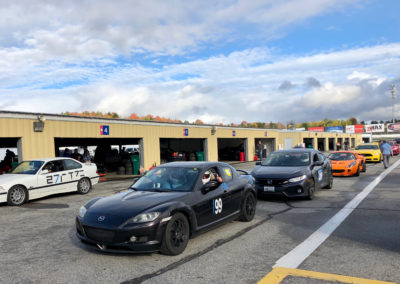While not a requirement, autocrossing can help a driver tackle a road course for the first time. Just ask Tamra Hunt.
Tamra Hunt has been competing in autocross for five years, making four visits to Solo Nationals, where she has accumulated two championships and two 2nd place finishes.
At each autocross event, track time is minimal compared to other racing verticals such as road racing. Most autocross runs last round 60 seconds. But according to Hunt, “Those 60 seconds are some of the most exhilarating moments of my life. Pure, raw driving with no fear of crashing. I get to push the car to its absolute limits… and it’s addicting.
“However, when I tell people I race cars, their first question is usually. ‘Oh sweet; have you been to Lime Rock?’ (She lives in Connecticut, where Lime Rock Park race track resides.) Then I go into this awkward explanation of ‘No, I actually race in parking lots or abandoned airports on a course made of cones, and I’m racing against the clock, not wheel to wheel on a race track.’ In fact, I’ve never even been on a race track!”
But Hunt decided to change that earlier this month, signing up for her first High Performance Driver’s Education (HPDE) day at New Hampshire Motor Speedway in a very low modified 2005 Mazda RX-8 Shinka.
“As the day approached, my nerves were already high, having watched videos of others at NHMS. I had the sudden realization that I was going to be on a real track, with concrete barriers that appear excessively close, and a long straight that will have me going faster than I ever have on the street. Unfortunately, the weather didn’t cooperate and we woke up to a steady drizzle on Saturday morning. I knew all of the risks would be even higher, and a spin in those conditions could have great consequences.
When she and her fiancé, who she shares the car with, got to the track, they knew they would get multiple sessions on the track with an instructor in the passenger seat, utilizing a headset and microphone to communicate with ease. In addition to this in-car support, the HPDE provided classroom instruction, encouraging her to get familiar with the track and the elevation changes. A little more at ease, Hunt took to the course.
“In my first few laps, I was making note of sections I considered particularly risky, like corner 10, which was off camber with a concrete wall on the outside, or corner 3, which I was flying into at 90+mph and threshold braking down to 2nd gear. With the wet conditions, I was making mental notes of where the water wasn’t draining, where there was a surface change that could cause the car to step out, or where one surface was more slippery than another. So many things were running through my head that I don’t usually have to think about at autocross.
The instructor was initially very cautious, but as Hunt gained familiarity with the track and he gained familiarity with her driving, he allowed her to push the car to higher speeds.
“I believe my autocross background helped me get a jump start on getting up to speed. Running in the novice group, I was regularly catching up to others who didn’t have the same autocross background as me, and I could witness their struggles with some of the basic concepts of performance driving, while I was waiting for a point-by. (There is no open passing in beginner HPDE days – one has to wait for the driver in front to signal that the driver behind him or her can pass – for safety reasons.) In that moment, I was greatly appreciating that I started with autocross and had already gained car control skills and natural good habits for looking ahead and picking out good lines, so I could put all of my focus into learning the track and picking up the pace.
One thing that surprised her was that she didn’t think about how fast she was going.
“I thought that going 100+ mph on the track would feel different than 60mph at an autocross, but it didn’t to me. But it sure sounds cool when I recapped my weekend to my co-workers!”
When discussing her initial impressions of the main differences between autocross and road racing, Hunt commented about some of the basics.
“I had to regularly shift between gears versus primarily stay in 2nd gear in autocross. I was more acutely aware of the risk I was taking and that every time the rear of the car stepped out, I was risking greater penalties. This resulted in my tending to drive closer to 90 percent than 100 percent, which is a different mindset than in autocross.”
When the day came to a close, Hunt was able to relax a little and exclaim, “Ultimately, I had a great time, and the car and I made it through our first time on the track unscathed!”
For us at Mazda Motorsports, knowing Tamra Hunt, this was no surprise, but a well-received notion nonetheless.
In the coming days, we will hear from Tamra Hunt about what she did to prepare for the HPDE experience – more than just autocrossing.
